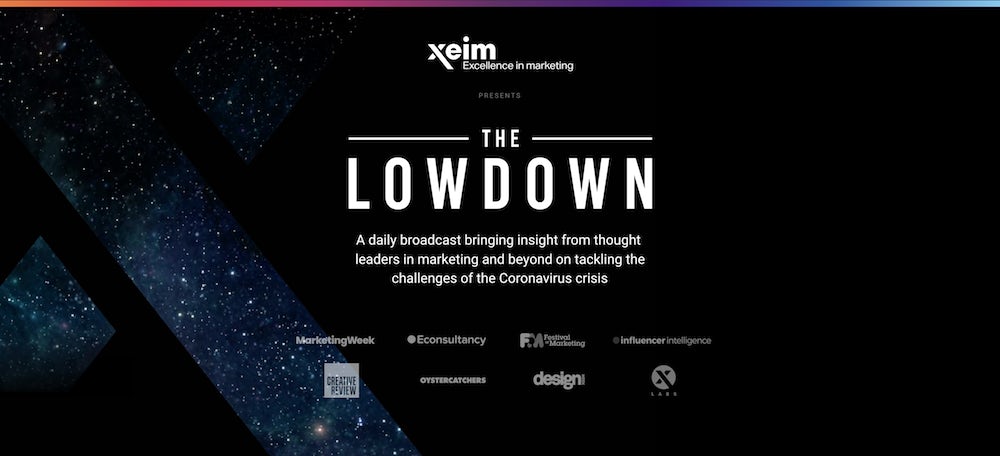We’ve been talking to leading marketers about business during the pandemic. Today it’s the turn of Gregor Young, a senior digital product and marketing leader who has recently been working at Channel 4 as Head of Digital Acceleration, and before that was Head of Group Digital Product and Marketing at BT.
Hi Gregor. Please describe your job, what do you do?
I’m a senior digital product and marketing leader. I usually wear two hats: one is an operational owner of digital products or channels; the other is a transformation leader, identifying where the business needs to change, developing strategy and then seeing through the change. I occupy the crossover between product and marketing experiences and define the digital, data and technology capabilities that underpin them as well as digital ways of working.
How has your typical day been impacted in the short term by the pandemic?
More time with the family has been wonderful, we’re bonding a lot with reading and going out for walks together. Adapting to new routines and roles has been very challenging but we’re always improving. I’ve also managed to rope the grandparents into homeschooling our kids over zoom calls which is a win for everyone.
At work I’ve had to direct a lot more of my time and attention to my operational responsibilities. There are a number of challenging marketing dynamics that I’ve had to react to, but there are also opportunities. For example, auction-based online advertising such as search and social media have become interesting all of a sudden: if you can afford to spend there, now is a great time with increased online traffic and decreased advertising spend in the marketplace, there are a lot of cheap impressions to be had.
What are your favourite tools and techniques to help you get your work done at the moment?
I have a software development and digital product background, so have been using agile management for some time. I always run continuous optimisation sprints in my operational teams with a performance dashboard, a kanban task board, stand-ups, retrospectives and the rest. I religiously hold weekly performance reviews where we discuss OKR performance, intervene, hypothesise, try things and bank learnings. In my opinion this is vital to running any product or channel and I implement this way of working everywhere I go.
With transformation programmes I’m often working with experts from across the business in different virtual teams. I have many conversations going on with each teams’ plans, files and task lists. I’ve found MS Teams to be a fantastic tool to bring everything together. It has replaced 5 or 6 separate tools that I used to rely on, (such as Slack, Trello and Google Docs), and is great for collaboration and transparency. Having it all in my phone is great too as I often have shower-thoughts that I need to quickly capture and put in the right place to be considered properly later.
Which companies have impressed you since the outbreak?
I was impressed by some of the quick turnaround products at the start like BrewDog’s sanitiser. Some of the online fashion retailers, such as Missguided, have done well, too, to quickly redirect their proposition from going-out clothing to loungewear. To act quickly and stay on-brand relies on agility and a strength in your own brand awareness and understanding.
It’s also been great to see some organisations forgoing revenue and opening their doors to provide a social service whilst doing a bit of brand building at the same time. National Trust for example initially opened their estates to everyone before the lockdown escalated. Also, my kids listen to all the children’s stories made free on Audible. Its hard to justify these things commercially and it relies on a long-term belief that these gestures will pay back in brand love.
What changes should brands be making to connect with how people are feeling and experiencing the pandemic?
Personally, I don’t appreciate the platitudes. My bank or utility telling me “we’ll get through this together” is laughable unless they’re actually going to provide something useful. As a customer, I’d rather they kept quiet. I think the best approach is to recognise what challenges your customers are facing and then deliver something helpful that only you can provide. The BBC developing their bitesize content for exasperated parents was a great move. Joe Wicks has become the nation’s champion by creating a solution to a problem everyone is experiencing that he is perfectly placed to deliver.
What trends have you seen in the last few weeks?
There is a lot more online activity. A lot more viewing, searching and connecting online. There is also a lot less advertising spending going on with companies looking to rein in their budgets. This was dramatic at the start of the lockdown, but it is easing somewhat with many advertisers slowly dialling it back up.
Generally speaking, everyone seems to be settling in to the new normal, having quickly gone through their own personal digital transformations. Colleagues are getting used to video-based meetings and balancing their days more after the frantic first few weeks. They’re also learning to get through with lighter teams with many on furlough. At home relatives and friends are connecting more over video-calling get-togethers and our family has a new routine. “Why didn’t we do this before?” and “I’ll definitely keep doing this when everything is back to normal” are daily sentiments.
What advice would you give a marketer right now?
We’ll bounce back from this and for many brands this period is an opportunity to build for the future. I’ve always been an advocate for two key factors that organisations need to develop. Firstly, the agility to quickly identify opportunities to improve and change tack accordingly. This comes from a discipline of consistent measurement, learning and decision-making. Secondly, a strong brand DNA across an organisation to be able to deliver reactive product and marketing changes that hit the right marks. The pandemic has highlighted how important these two factors really are with the brands that have these winning over customers’ hearts.
Where you can, set yourself up for continuous optimisation. Read up on OKRs, set up a weekly performance review, create a metric dashboard and start understanding what levers you have to pull to drive performance, test and learn.
What does long term planning and strategy look like now?
It’s hard. It has been too easy to write off longer term initiatives as not business critical. I’ve had some longer term deliveries frozen in time as critical people are furloughed. It’s ironic for me as its my job to help organisations embrace digital more which is what most brands need to do faster now. This crisis has no doubt pushed this up the board level agenda, but some of the things that need to be done take time and investment which there isn’t so much appetite for when the benefits are further down the line.
On the plus side, there are many aspects of digital transformation that have accelerated in the past few months such as adoption of collaboration tools, a greater focus on digital channels and quality of digital experience getting the attention it deserves.









